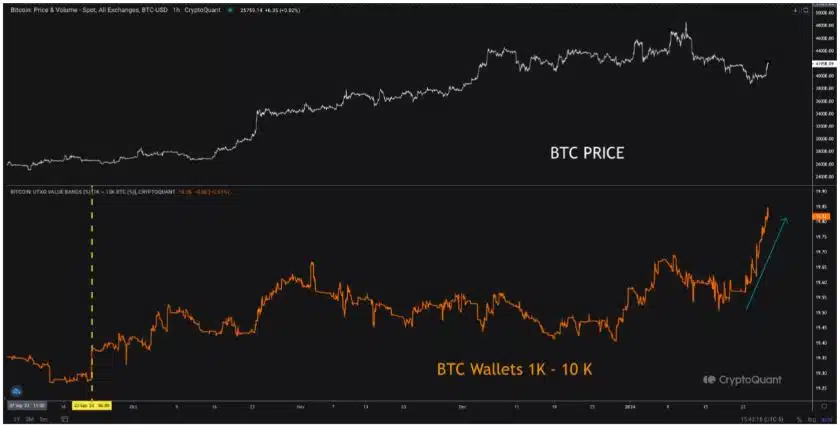The leading cryptocurrency, Bitcoin (BTC), has experienced a significant decline since the approvals of spot ETFs, triggering negative opinions among investors. What are the latest data on Bitcoin?
Increasing Wallet Count in Bitcoin
Analysts doing their part regarding the expected medium and long-term pricing of Bitcoin, the flagship of the markets, have indicated that large accumulations of Bitcoin continue. According to CryptoQuant, there was a sharp increase in the number of wallets holding between 1,000 and 10,000 Bitcoin throughout January. This occurred despite a 12% drop in price since the peak on the day of the ETF approval.
Data from IntoTheBlock reveals that whale investors have increased their cryptocurrency holdings by 76,000 since the beginning of the year, which amounts to more than 3 billion dollars at current market prices. Experts were expecting a significant capital influx into the Bitcoin market following the approval of spot ETFs. Additionally, it was indicated that the leading cryptocurrency could reach 100,000 dollars by the end of the year and approach 200,000 dollars by the end of 2025.

Long Positions in BTC
These positive forecasts might cause experienced investors to disregard short-term volatility and continue their accumulations. A different measure reflecting the whales’ bullish stance on Bitcoin is the number of long positions they hold. According to analyses related to Hyblock Capital data, more than 60% of whale accounts on Binance were in long positions in BTC at the time of writing. Long positions have sharply increased since the approval of spot ETFs, bolstering the mentioned arguments.
Furthermore, according to data from the analytics platform SoSo Value, Bitcoin continued to see an outflow with a net exit of 255 million dollars from the Grayscale Bitcoin Trust ETF (GBTC) on Friday. ETFs other than Grayscale recorded a net inflow of 269 million dollars. Since listing, spot ETFs had accumulated 756 million dollars as of January 26, while GBTC experienced a significant decline due to an outflow of over 5 billion dollars.

 Türkçe
Türkçe Español
Español









